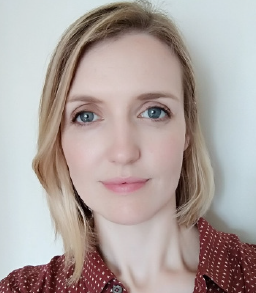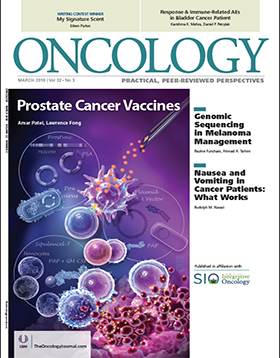My Signature Scent
Late last year, ONCOLOGY hosted a writing contest on CancerNetwork.com, in which we asked our readers to share their personal experiences with delivering bad news. The essay by Dr. Eileen Parkes from Queen’s University Belfast, United Kingdom, was selected as the first place winner.
Oncology (Williston Park). 32(3):96-7.

Eileen Parkes, MD, PhD

Late last year, ONCOLOGY hosted a writing contest on CancerNetwork.com, in which we asked our readers to share their personal experiences with delivering bad news. The Editors-in-Chief of the journal-Dr. Nancy E. Davidson, Dr. Nora Janjan, Dr. Julie M. Vose, and Dr. William C. Wood-judged the entries based on whether they provided a clinical lesson; offered perspectives from both the doctor and patient; were eloquently written and descriptive, and would have an impact on a wide audience of oncology professionals. The essay by Dr. Eileen Parkes from Queen’s University Belfast, United Kingdom, was selected as the first place winner.
*****
I lingered behind in the patient’s room at the end of the ward round, after seeing his eyes widen as he absorbed the upsetting news. My consultant moved on; he had other patients to see, clinics to run, and meetings to attend. “Was there anything else you wanted to ask?” I ventured, scared of what the answer might be. The man glanced at his wife, then looked steadily back at me.
I had met him for the first time at clinic that week. He was in his early 40s, younger than many of my patients. He described a chest pain that caught his breath, and I had arranged an urgent CT scan, which confirmed my suspicion of a pulmonary embolus. This unscheduled CT had also flagged up the fact that his cancer was growing, despite treatment-a craggy mass in his stomach, which could be felt easily through his thin frame. Just a few short months ago, he had started what was hoped to be a curative treatment, leading to surgery and getting him back to day-to-day life in less than a year. But the cancer we were treating had other ideas; it had continued to grow, rendering the surgical plans impossible. Curative treatment strategies had been replaced with palliative care, and the patient enrolled in a clinical trial to take every therapeutic opportunity available. It was early in the trial, however, and it would be another few weeks before we would have a definitive answer regarding the effects of treatment.
On his third hospital admission in as many weeks, he was visibly frustrated, and announced, “I don’t want to live like this.” This floored me; not knowing what to say, I simply nodded. “I’m used to being outdoors, working outdoors, being active,” he told me. “I hate being cooped up in here.” Still at a loss for words, I waited for him to speak. Finally, he had a request: “Tell me again what the CT said about the cancer.”
“There are suggestions that, despite the treatment, the cancer has continued to grow,” I explained. “However, this scan is earlier than we would usually expect and …” I trailed off. “So it’s not working,” he said bluntly. I turned toward his wife, who held my gaze. “It doesn’t look that way right now,” I replied. “I’m sorry. There are other options we may be able to explore.”
“I don’t want to spend my time here anymore,” he said. I wasn’t prepared for this. My consultant was expecting to have another CT scan performed on this patient in just a few weeks, since, despite the recent hospital admissions, he had remained active-and even if the CT results failed to show a clinical response, other treatment options could be considered. Yet the patient was insistent. “I want to be at home,” he said. “What’s the chance I’ll end up in hospital again if I continue the treatment?”
I was a brand-new trainee in oncology, just a few weeks in. I had not yet learned the nuanced approach and skills needed to communicate bad news. Somehow, though, my patient and his wife had put their faith in me to advise them on this most difficult of days, and I could not fail in this task. “Tell me about the last few weeks,” I said.
They told me about repeated hospital admissions, precious time spent away from family, and the disappointment of treatment delays and more investigations. The CT scan result had only confirmed their suspicions. They did not want to pour their energy into further treatment, but into making their remaining time together as full of life as possible. Feeling that I did not have the skills to advise them, I simply listened. They made their decision together, as they talked.
“Will you tell our children?” they asked me. Their daughters, age 17 and 19, had just arrived at the ward. They are too young to lose their father, I thought.
Reeling at the confidence they had placed in me to perform this task, and feeling overwhelmed, I nevertheless agreed. With their parents present, I spoke to these young women, slowly talking through the CT results and their implications, the problems with treatment, and the need to balance the quality and quantity of life. They asked only a few questions. I remember that they constantly looked over at their father, absorbing the impact of my words. Leaving them together with their parents, I arranged for the palliative care team to call on them later, found a quiet corner, and let my tears spill over.
My patient went home the next day. Several weeks later I heard that he had died peacefully. I sent my first sympathy card as an oncologist.
Sometime afterward, a package appeared in my post, from my patient’s family. Opening it, I found a bottle of perfume, far costlier than any I had owned before-and a thank-you card, of all things! I was impressed that I was being thanked for my short-lived care of their husband and father.
Somehow, my first stumbling attempt at delivering the worst of news had mattered to them, and had made a difference in the quality of their beloved’s last weeks of life. They had been at peace, facing the final weeks without fear, knowing he was where he wanted to be. Their courage was greater than I had anticipated.
That scent is a daily reminder of the bravery of patients and their families, and I continue to be surprised at their resilience and strength. For all the communications training that I have undergone since that first experience with delivering serious news, this patient and his family taught me the most important skill: learning how to listen to what matters to patients and their loved ones. It is not about “chancing” patients with percentages or averages; it is about treating each patient and family member individually, and attempting to understand their distinct needs, priorities, and fears. My signature scent, rather than reflecting my personality, instead reminds me of my patients-and of the need to hear, be still, and listen.
*****
The Trauma of Facing Death
Nora Janjan, MD, MPSA, MBA
One of the foundations of oncology is hope. Hope deals with the emotional and physical trauma associated with the diagnosis and treatment of cancer. While many oncologists no longer consider death a “failure,” it is still difficult to accept situations when treatments cannot deliver the hope of cure or the prospects of a meaningful period of survival. When treatments fail, the focus of patients and their caregivers transforms from the hope of survival to the hope that the patient will not suffer during the process of dying.
This issue of ONCOLOGY includes a powerful perspective on delivering bad news. This personal reflection was submitted as an entry to a recent writing contest published
on CancerNetwork.com, the online home of ONCOLOGY. Qualifying submissions were required to provide a compelling takeaway lesson for daily clinical practice regarding doctor/patient relationships and communication, and to offer both physician and patient perspectives. All 25 of the essays we received had something in common; they related the most difficult emotion ever faced: that of the trauma of impending death. These experiences-some of which occurred more than 20 years ago-have left an indelible imprint on the physicians who shared them.
The contest winner, “My Signature Scent,” by Eileen Parkes, MD, PhD, is more than a poignant reflection of the doctor/patient relationship. It also offers an important perspective on how we, as physicians, handle the profound responsibility of providing support to patients and their families during times of crisis. Delivering bad news is often most difficult at the point when hope is first lost, and not necessarily at the end of life.
There are many lessons to be learned from this enduring experience related by Dr. Parkes, although it occurred many years ago. The attending physician “moved on” and relegated delivering bad news to her, a new trainee in oncology. Inconsistent with standards of care, the attending physician abandoned the patient and the oncology fellow, most likely to avoid the grief of lost hope. Rather than model the attending’s behavior, this experience reaffirmed Dr. Parkes’ own moral compass through unforgotten pain and concern for this patient and his family, and for innumerable patients and families to come.
Death is finite for the patient. However, each of the submissions related the lasting, often generational, scars that occur in the living with the trauma of facing the death of a loved one. As oncologists, it is our responsibility not only to deliver the hope of survival, but also to deliver bad news with profound empathy and an understanding of the permanent impact of this loss on those who remain.
